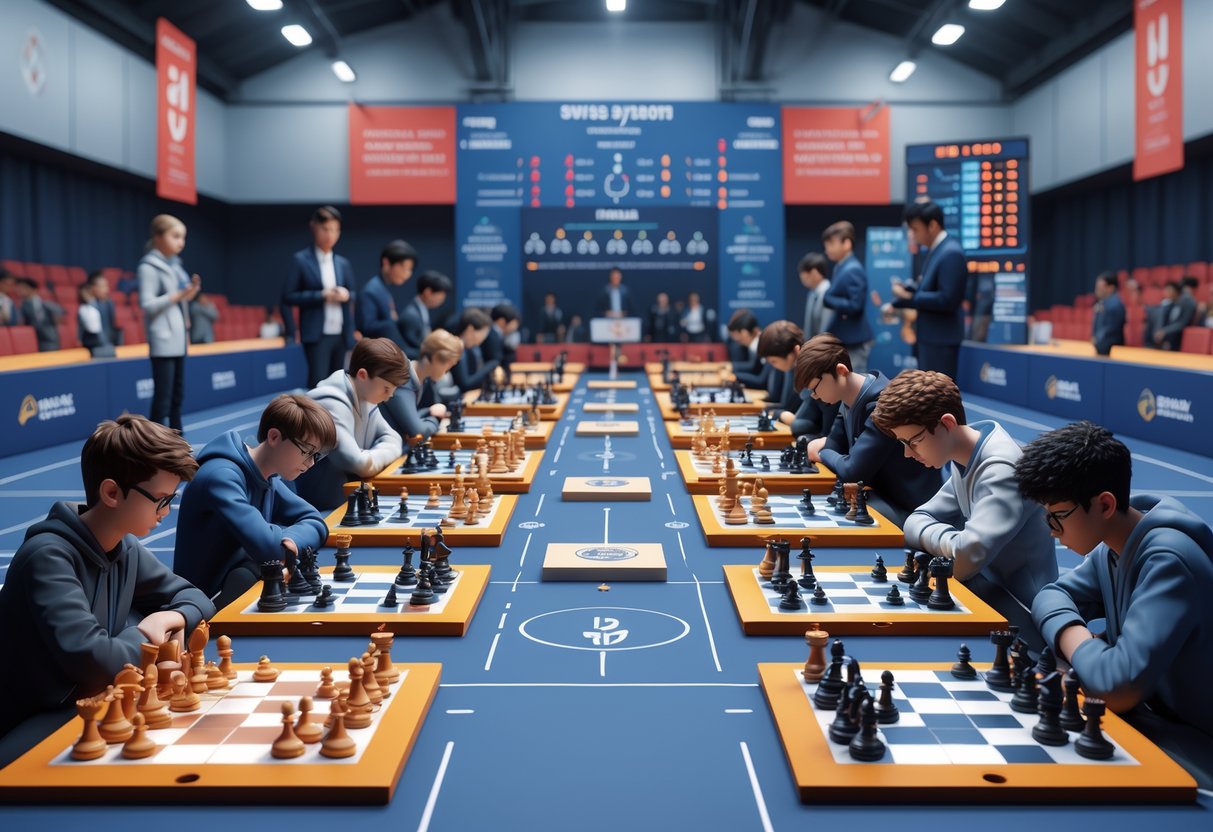Swiss System Advantages: Why It’s the Ideal Tournament Format
Updated On: November 12, 2025 by Aaron Connolly
Core Advantages of the Swiss System
The Swiss system tournament format brings three big benefits, making it a favorite for competitive gaming events. Players compete in a set number of rounds and nobody gets eliminated, all while keeping matchmaking balanced from start to finish.
Ensuring Fair Competition
The Swiss system actually creates fair competition by pairing players with similar skill and performance. After round one, we match competitors based on their current points, not just their starting rank.
So, if a lower-rated player does well, they’ll get to play against tougher opponents next. Meanwhile, higher-rated players who stumble early will find themselves up against competition closer to their level.
Key fairness features:
- Players face others with similar scores
- No one meets the same opponent twice
- Colour distribution stays balanced
- Your performance, not your starting rank, shapes future pairings
This setup stops weaker players from only facing each other, while strong players don’t just breeze through a separate bracket. Everyone’s final standing comes from their performance against well-matched opponents.
Tournament organisers can look at the final standings and actually feel confident they reflect the real skill shown during the event—not just lucky pairings or rough early draws.
Non-Elimination Format Overview
The Swiss system doesn’t kick anyone out, no matter how the first rounds go. Every player gets to play every scheduled round, and honestly, that’s a huge plus for both players and organisers.
Players really get their money’s worth for their entry fee. Win or lose your first game, you’ll play just as many rounds as everyone else.
Benefits of no elimination:
- All players get the full tournament experience
- Bad early results don’t end your run
- More games mean better skill assessment
- Venues keep a steady number of players
Organisers don’t have to stress about shrinking player pools or changing logistics. Venue needs, staff, and schedules stay predictable from start to finish.
This format also takes a load off players’ minds. One bad game won’t crush your whole tournament, so you’ll see more aggressive and entertaining play.
Balanced Pairings Each Round
Swiss tournaments really shine when it comes to competitive balance. The pairing algorithms make sure each round features matches between players of similar strength, so you get a lot of close games.
The system groups players by points, then matches them within those groups. If you’re on 3 points, you’ll face someone else on 3 points—nobody gets an unfair advantage.
Pairing priorities:
- Match players with the same point totals
- No repeat pairings
- Keep colours (white/black pieces) balanced
- Handle byes if there’s an odd number of players
This keeps games competitive right up until the last round. Players hardly ever get paired against someone way above or below their current level.
You’ll see engaging competition across the board. The top players fight for the win, while everyone else still has something to play for against others at their level.
Efficiency with Large Numbers of Participants

The Swiss system handles huge tournaments—think hundreds or thousands of players—without dragging on forever. It needs way fewer rounds than other formats and really makes the most of every time slot.
Reduced Number of Rounds Needed
Round-robin tournaments make everyone play everyone, but that just isn’t practical with big groups. Swiss tournaments use a smart math trick: A 128-player event only needs 7 rounds to find a winner.
Just use log₂(number of players) = rounds needed. So 256 players? That’s 8 rounds. 512 players? Only 9 rounds.
Round-robin gets ridiculous fast. With 100 players, you’d need 99 rounds. Swiss tournaments shrink that to just 7 rounds for the same group.
Major esports events like CS use this all the time. BLAST Premier events often feature 16 teams and get through group stages in 4-5 rounds instead of the 15 rounds a full round-robin would need.
| Players | Swiss Rounds | Round-Robin Rounds |
|---|---|---|
| 32 | 5 | 31 |
| 64 | 6 | 63 |
| 128 | 7 | 127 |
| 256 | 8 | 255 |
Optimal Use of Time and Resources
Swiss tournaments keep all participants playing at once. Every round fills every available playing station—nobody gets knocked out early.
Knockout brackets waste space as time goes on. A 64-player knockout starts with 32 matches, but by the final, you’re down to just one. Swiss keeps the venue buzzing the whole time.
Organisers save cash on long venue bookings. A 128-player Swiss event wraps up in a weekend instead of stretching over weeks.
This format is especially great for online esports. Riot Games uses Swiss for League of Legends tournaments, scheduling matches efficiently across time zones. Players know exactly when they’ll play.
Heads up: Swiss tournaments do need solid scheduling software to pair players right every round. But the effort pays off with fewer staff and venue headaches.
Contrast with Other Tournament Formats
Swiss system tournaments land somewhere between the marathon of round-robin and the cutthroat nature of knockouts. Each format has its place, depending on how many players you have, your time limits, and what you want out of the event.
Swiss System vs. Round-Robin
Round-robin events make everyone play everyone else. You get the most complete results, but it gets out of hand fast.
Time and logistics are the big difference. A 100-player round-robin means 4,950 matches. A Swiss event with the same group? Only 700-800 matches over seven rounds.
Accuracy of results is a trade-off. Round-robin gives the most accurate rankings because everyone faces the same opponents. Swiss gets you pretty close but keeps things manageable for big groups.
Participant experience shifts too. Round-robin gives everyone the same number of games. Swiss makes things tougher for top players as the event goes on.
Practical applications? Local, small events often use round-robin. Big championships with hundreds of players rely on Swiss to get things done efficiently.
Swiss System vs. Knockout Tournament
Knockout tournaments send players home after a loss, which can be dramatic but cuts participation short. Double elimination gives a second chance, but even then, plenty of players leave before the end.
Player retention is where Swiss wins. Everyone plays every round, no matter the results. Knockouts can cut half the field after just one round.
Excitement levels are different, too. Knockouts build up to a huge final, and the stakes always feel high. Swiss keeps the competition steady, though maybe without the same dramatic tension as elimination matches.
Skill development comes easier in Swiss. Weaker players get more games against others at their level, instead of getting knocked out by top seeds right away.
Organisational efficiency really depends on your goals. Knockouts finish faster and need fewer matches. Swiss takes more rounds, but you can fit way more players in without making the event last forever.
Adaptability to Different Games and Sports

The Swiss system works across all sorts of competitive games, from classic board games to modern esports. Chess has used it for ages, and esports picked it up for its flexibility with big online crowds.
Prominence in Chess Tournaments
Chess tournaments lean heavily on the Swiss system because it handles big groups so well. Unlike knockouts, everyone gets to play several games, even after early losses.
Major chess events using Swiss format:
- Chess Olympiad qualifiers
- Open tournaments with 100+ players
- Weekend club competitions
Organisers pair players with similar scores each round. If you’re on 3 wins, you’ll play someone else on 3—not someone who’s lost every round.
This keeps matchups fair all the way through. Strong players naturally rise to the top, and weaker players don’t get knocked out right away.
Key benefits for chess:
- Flexible rounds: Organisers can run 5, 7, or 9 rounds as needed
- No eliminations: Everyone plays every round
- Balanced competition: Players face others with similar results
Adoption in Esports and Board Games
Esports tournaments have really embraced Swiss for online qualifiers and group stages. Games like Counter-Strike, Dota 2, and Rocket League all use this format.
The system handles big online tournaments with ease. Hundreds of teams can compete at once, and scheduling isn’t a nightmare.
Popular esports using Swiss format:
- CS Major qualifiers: Teams need 3 wins to advance, 3 losses to go out
- Dota 2 tournaments: Group stages before knockouts
- Rocket League championships: Online qualifiers for live events
Board games beyond chess use Swiss, too. Scrabble, bridge, and Go tournaments all benefit from these pairings.
Players get several chances to prove themselves, and nobody faces the same opponent twice. The format keeps things manageable and fun.
Player Experience and Development
The Swiss system creates a supportive space where everyone can improve, round after round. As players perform better, they get tougher opponents, but there’s always a chance to bounce back from early mistakes.
Continuous Play for All Competitors
Swiss tournaments make sure every player stays in for every round. Unlike knockouts, where one bad match can end your day, here you keep playing from start to finish.
This matters a lot for players who want to improve. Each round brings new learning opportunities against different opponents and playstyles.
Newer players don’t have to deal with the sting of early elimination. They get to see how stronger players handle things in later rounds.
Parents who plan tournament days for their kids can count on predictable schedules. You’ll know when each round happens, and it’s easier to support young competitors between games.
Organisers also benefit. Players stay engaged, and spectators stick around because their favourites are still playing.
Opportunities for Recovery After Losses
Early losses don’t ruin your tournament in Swiss. The system automatically pairs you with others who’ve had similar results.
If you lose your first two games, you’ll play someone else having a rough start. These are meaningful matches where anyone can win.
Swiss tournaments really teach recovery and resilience. Players learn to adjust and come back after setbacks. These mental skills are huge in competitive gaming.
The format rewards steady improvement over perfect starts. If you finish strong, you can still climb the rankings, even after a rocky beginning.
Swiss tournaments mirror the real esports world, where comebacks happen all the time. Teams often recover from shaky starts to reach the finals.
Pairing Mechanisms and Seeding Principles

The Swiss tournament format builds balanced matchups using smart pairing algorithms and smart seeding. These systems make sure players face opponents with similar skills and don’t get stuck playing the same person twice.
Round-by-Round Pairing Algorithm
The pairing system changes after each round, depending on current standings. Players with the same scores usually face each other in the next round.
Initial Round Seeding:
- Organisers rank players by skill rating or past results.
- Top-ranked players get paired against those in the middle.
- Players in the bottom half play each other.
Subsequent Round Logic:
- Winners from the first round face other winners.
- Players on 1.5 points get matched with others on 1.5.
- The system keeps things balanced so competition stays fair.
The algorithm also handles colour assignments. Players switch between white and black pieces each round. Nobody gets the same colour three games in a row.
Accelerated Pairing Systems:
Some tournaments use accelerated pairings in early rounds. This splits players into sub-groups so top players don’t meet too soon. The system gives out “pseudo points” just for pairing, not for the actual standings.
Avoiding Repeat Matchups
The Swiss system makes sure no two players face each other twice. As tournaments go on, this gets trickier.
Pairing Constraints:
- Software keeps track of all previous games.
- The algorithm finds valid matchups inside each score group.
- If needed, the system shifts players between brackets to avoid repeats.
When perfect score-group pairings aren’t possible, the system adjusts. Sometimes a player faces someone with a slightly different score to prevent a repeat.
Bye Allocation:
If there’s an odd number of players, one person gets a bye each round. The system rotates this so everyone gets a fair shot, and nobody gets more than one bye unless it’s unavoidable.
Modern pairing software like ChessManager takes care of all these calculations. These programs follow FIDE rules and handle huge events without much fuss.
Scoring and Standings Calculation
Swiss tournaments use a simple point system. Players earn points for wins and draws. Rankings depend on total points, and tie-breakers sort out deadlocks.
Points Allocation for Wins, Draws, and Losses
The scoring system in Swiss tournaments is pretty straightforward. Players get 1 point for a win, 0.5 for a draw, and 0 for a loss.
This system applies in every round. After each round, organisers add up the points to show the current standings.
Some events use a 3-1-0 system—3 points for a win, 1 for a draw, 0 for a loss. This setup pushes players to go for wins instead of settling for draws.
| Result | Standard Points | 3-1-0 System |
|---|---|---|
| Win | 1 | 3 |
| Draw | 0.5 | 1 |
| Loss | 0 | 0 |
The tournament director announces the scoring system before the games start. Most chess and esports Swiss tournaments stick to the 1-0.5-0 system.
Tie-Breaking Procedures
When players finish with the same points, tie-breakers step in. The most common is Buchholz score—the total points earned by all your opponents.
Sonneborn-Berger score is another popular one. It gives more weight to beating strong opponents by multiplying your points against each opponent by their final score.
Swiss tournaments usually apply several tie-breakers in order:
- Buchholz score (opponent strength)
- Direct encounter (if players played each other)
- Sonneborn-Berger score
- Number of wins with black pieces (in chess)
Organisers run through these tie-breakers one by one until all ties break. Tournament software does the math, so nobody has to crunch numbers by hand.
Flexibility in Tournament Scheduling

The Swiss system adapts easily to different time limits and player counts. Organisers can tweak the number of rounds based on the time available and how accurate they want the rankings.
Setting the Number of Rounds
Swiss tournaments work with any number of rounds that fits the schedule. Unlike knockout brackets, you don’t need a perfect number of players. The system handles 3, 5, 7, or even 10 rounds just fine.
Most chess tournaments use this formula: log₂(number of players) = minimum rounds needed. For 64 players, that’s at least 6 rounds. But if you’re tight on time, you can run fewer.
Weekend tournaments often go for 5-6 rounds. Online events sometimes do 3-4 quick rounds. Big championships might run 9-11 rounds for maximum accuracy.
More rounds mean better rankings but take more time. Fewer rounds finish fast but might not separate the top players as clearly.
The main thing is choice. Organisers pick the number of rounds that fits their event.
Accommodating Various Time Constraints
Swiss tournaments fit almost any time slot because we decide the round count. A short lunch-break event can squeeze in 3 rounds in 90 minutes. A weekend event might have 9 rounds over two days.
Time flexibility examples:
- 2-hour event: 4 rounds with 25-minute games
- One day: 6-7 rounds with breaks
- Weekend: 9 rounds split across Saturday and Sunday
Late entries don’t mess things up. Players joining in round 2 start with zero points and get paired as normal. The system just adapts.
Withdrawals aren’t a problem either. If someone leaves, their next opponent gets a bye, and everyone else keeps playing. No brackets collapse, and nobody scrambles to fix the schedule.
This flexibility makes Swiss tournaments ideal for events with unpredictable turnout or tight venue bookings. You know exactly when the event wraps up, no matter what.
Fairness and Balance in Opponent Selection

The Swiss system keeps things fair by matching players with similar scores. This approach makes sure everyone faces opponents close to their level, not just random matchups.
Matching Players by Similar Scores
Swiss tournaments pair players based on their current standings. People with the same score get matched up first.
How it works:
- Round 1: Pairings are random since nobody has points yet.
- Round 2: Winners play winners, losers play losers.
- Round 3 and beyond: Players get grouped by total points.
This setup creates natural skill tiers. A player with 3 wins faces another 3-win player—not someone with just 1 win.
The perks:
- Strong players don’t keep beating up on weaker ones.
- Every match feels competitive.
- Final rankings actually show who played best.
After a few rounds, top scorers battle each other, while middle and lower ranked players get fair games too.
The system blocks “easy wins” that can throw off the standings. Every victory matters because it comes against someone at your level.
Balanced Colour Assignment in Chess
Chess tournaments need fair colour assignments since playing white usually helps. The Swiss system keeps track of colours for each player.
Colour rules:
- Players should get about the same number of whites and blacks.
- The system tries to alternate colours when possible.
- If someone’s had more of one colour, they get the other.
Tournament software checks both score and colour history to find the best pairings.
For example: If two players with the same score need pairing, the one who’s had more blacks gets white this round.
This stops strong players from always getting white against tough opponents. Over several rounds, colour advantages even out.
The system also avoids giving anyone the same colour three times running. That keeps things fair for everyone.
Gaming expert James Connolly points out that good colour balance really impacts final standings. No one should get an edge just from colour assignments.
Suitability for Scholastic and Amateur Events

Swiss tournaments work especially well for school competitions and amateur events. They handle mixed skill levels fairly and keep everyone involved. Players don’t get knocked out early, so organisers can create meaningful matches for all.
Sectioning by Skill, Age, or Rating
Swiss tournaments shine in groups with different abilities, which is pretty common in scholastic events. Players start with ratings or age-based seedings, then face others of similar strength as the rounds go on.
In chess, a Year 7 student won’t play the school’s top player after round one. The system updates pairings after each round, so strong players meet other winners and beginners face each other.
Quick tip: Organisers can split events into sections. Under-16s can play in one group, while seniors or beginners have their own brackets.
This method works well for esports in schools too. Casual League of Legends teams don’t get stomped by the top squad every round. Instead, they play against teams at their own level, making matches more fun and educational.
Swiss tournaments avoid the pain of single-elimination. Players keep learning and improving, even if they lose a match or two.
Encouraging Broad Participation
Swiss tournaments keep everyone playing until the final round. That’s huge for school events, where participation matters more than just finding a winner. Students stick around all day instead of heading home after an early loss.
Parents like this format because their kids get more games for the entry fee. In knockout events, players might travel for hours and lose right away. Swiss guarantees everyone gets multiple games.
Heads up: Some players still finish near the bottom, but by the end, they’re facing others at their level.
Amateur chess clubs use Swiss tournaments all the time because the system works for any group size. Whether 12 or 120 people show up, organisers don’t have to worry about brackets or byes.
Weaker players are more likely to return for future events. They get competitive games instead of constant blowouts.
Organisational Advantages for Tournament Directors

Tournament directors get a lot out of Swiss tournaments. Scheduling is predictable, and running the event is just easier.
Predictable Tournament Duration
Swiss tournaments use a fixed number of rounds that organisers can plan before the event. Elimination brackets can drag on, but Swiss events finish right on schedule.
It’s easy to figure out the number of rounds. For chess, it’s usually the square root of players plus two. So, 64 players means 8 or 9 rounds at most.
Timing perks:
- Booking venues is simple.
- Staff can plan their shifts.
- Broadcasts start and finish on time.
- Prize ceremonies don’t get delayed.
All games in a round happen at once. Organisers don’t have to wait for slow matches before moving to the next round. This keeps things moving.
Directors can book venues confidently. No last-minute overtime or angry venue managers when things run late.
Simplified Event Management
Swiss tournaments don’t need much real-time decision-making. The pairing algorithm takes care of most problems.
Pairing software does the heavy lifting:
- Matches players based on scores.
- Assigns byes if there’s an odd number.
- Balances colours in chess.
- Stops repeat matchups.
No need for backup brackets or tricky seeding. The system adjusts as results come in and always finds fair pairings.
Staff numbers stay steady throughout the event. You always need the same number of referees, tables, and gear. No scramble if matches pile up like in elimination events.
Other admin perks:
- Fewer protests to handle.
- Easy resource planning.
- Automatic record keeping.
- Simple progression tracking.
Swiss tournaments keep everyone playing until the end. That means fewer refund requests and better attendance from start to finish.
Limitations and Considerations to Acknowledge

The Swiss system brings a lot of benefits to tournaments, but it’s definitely not perfect. Organisers should know about a few drawbacks before jumping in.
Pairing imbalances sometimes create unfair matchups. Tiebreak systems get messier as events get bigger.
Potential Pairing Imbalances
Sometimes, the Swiss system throws players into unfair situations where the competition levels just don’t match up. Every pairing depends on results from previous rounds, so luck can play a role.
Strength of Schedule Problems
Some players luck out and get easier opponents early on. Others might get thrown against the toughest competitors right from the start.
Player A could breeze through three weak opponents, while Player B has to fight three tournament favourites. Both might land similar scores, but it’s clear Player A had a smoother ride.
Colour Distribution Issues
In chess, it’s important to balance the number of games with white and black pieces. The Swiss system tries, but doesn’t always nail it. Sometimes a player ends up with an extra white game, and yeah, that’s a small but real edge.
Late Entry Complications
When players join after round one, it throws off the pairing balance. The system tries to fit them in, but usually gives them easier matchups to make up for missed rounds.
Challenges with Tiebreaks in Large Events
With hundreds of players, lots of them finish with the same score. Figuring out who actually ranks higher gets tricky, and people sometimes argue about the results.
Multiple Tiebreak Systems Needed
Big Swiss tournaments stack up several tiebreak methods. Organisers might use opponent strength ratings, head-to-head results, or other formulas. None of these are perfect, and each brings its own quirks.
Computational Complexity
Handling tiebreaks for massive events means you need good software. Doing it by hand? Forget it. Even tiny mistakes in the system can mess up the final rankings.
Player Understanding Issues
A lot of players don’t really get how tiebreaks work. That confusion leads to complaints if the standings feel off. It’s frustrating when you can’t check the math yourself or see why you placed lower.
Frequently Asked Questions

People have plenty of questions about the Swiss system—especially when it comes to fairness, efficiency, and whether it really works for all types of chess events. Here are some answers to the things tournament organisers and players ask most often.
What are the benefits of using a Swiss-system tournament in chess competitions?
Swiss tournaments give players more games, no matter how they start out. Knockout formats kick you out after one loss, but here, everyone keeps playing.
The system handles any number of participants. You could run a Swiss event with 10 or 100 players and the structure basically stays the same.
Organisers save time compared to round-robin events. Swiss tournaments need fewer rounds to find a winner in big groups.
Players face others with similar scores as the tournament moves on. The pairing system makes for more even and competitive matches.
How does the Swiss system ensure fair play among participants of varying skill levels?
The pairing system shifts matchups automatically based on how players are doing. After each round, players with similar scores face off in the next game.
If you win early, you get paired with other winners. If you lose, you’ll meet players with similar records, which keeps things fair and gives everyone a shot at points.
The system doesn’t let players face the same opponent twice. That way, everyone gets a mix of challenges.
Colour balance matters too. The system tries to give everyone about the same number of games with white and black pieces.
Can you explain how the Swiss system improves tournament efficiency compared to knockout formats?
Swiss tournaments skip elimination rounds, so nobody has to sit out early. Everyone plays the same number of games, win or lose.
You know how many rounds you’ll need before the tournament even starts. That makes scheduling way less stressful.
Venues can handle more players without dragging out the event. Adding 20 extra players might just mean one more round.
Swiss formats let organisers spread out prizes based on final scores, not just who comes in first.
In what ways does the Swiss system support larger participant numbers without significant delays?
The Swiss format really shines with big crowds. A 128-player tournament only needs seven rounds to pick a winner.
Round-robins just don’t work for huge fields. With 128 players, you’d need 127 rounds for everyone to play each other—no thanks.
Pairing software makes it easy to handle big numbers. Modern tools can sort hundreds of players in just a few minutes between rounds.
Everyone plays at once in each round. That keeps things moving and avoids slowdowns.
Why is the Swiss system particularly favoured for organising amateur or club-level competitive events?
Club tournaments usually have players of all different strengths. The Swiss system naturally separates them out as the event goes on.
Beginners end up facing other beginners after a round or two. That means new players aren’t stuck against experts for the whole event.
Entry fees stay reasonable since clubs don’t need to book venues for days on end. Shorter formats keep costs down for everyone.
It’s just more fun when nobody gets knocked out early. Players stick around for the full tournament, so the club vibe stays lively.
How does the pairing process in the Swiss system contribute to a competitive but balanced tournament atmosphere?
Score-based pairings push players into naturally competitive games. You usually end up facing someone who’s performed about as well as you have in previous rounds.
This system really shakes things up compared to formats with predictable matchups. Each round’s results actually shape who you’ll face next, so it’s hard to guess what’s coming.
As the tournament moves forward, you’ll notice rating differences shrink. Early rounds might toss you against someone much higher or lower, but later on, you’re more likely to get paired with someone close to your level.
It’s not unusual for multiple players to tie for the top prizes. Honestly, that just adds to the suspense—more folks have a shot at winning right up until the very end.

